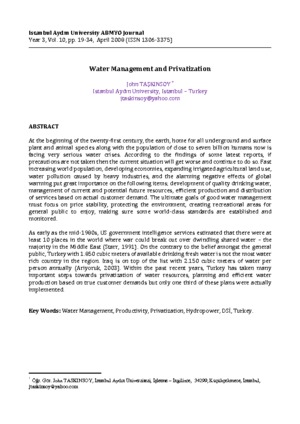- Suggested keywords :
- hundreds(2)
- non-contributing area(11)
- makes(1)
- heart(2)
- liquid(2)
List of Categories and SubCategories
Change Your Picture

Water Management And Privatization
JOHN TASKINSOY
VIEWS
1195
INFO
more

- Category : Environmental Studies
- Size : 572955
- By : JOHN TASKINSOY



Using Your Google Account
Google Login/Sign up
OR
Recover Your Password
Abstract
At the beginning of the twenty-first century, the earth, home for all underground and surface plant and animal species along with the population of close to seven billion humans now is facing very serious water crises. According to the findings of some latest reports, if precautions are not taken then the current situation will get worse and continue to do so. Fast increasing world population, developing economies, expanding irrigated agricultural land use, water pollution caused by heavy industries, and the alarming negative effects of global warming put great importance on the following items; development of quality drinking water, management of current and potential future resources, efficient production and distribution of services based on actual customer demand. The ultimate goals of good water management must focus on price stability, protecting the environment, creating recreational areas for general public to enjoy, making sure some world-class standards are established and monitored.
As early as the mid-1980s, US government intelligence services estimated that there were at least 10 places in the world where war could break out over dwindling shared water – the majority in the Middle East (Starr, 1991). On the contrary to the belief amongst the general public, Turkey with 1.850 cubic meters of available drinking fresh water is not the most water rich country in the region. Iraq is on top of the list with 2.150 cubic meters of water per person annually (Ariyoruk, 2003). Within the past recent years, Turkey has taken many important steps towards privatization of water resources, planning and efficient water production based on true customer demands but only one third of these plans were actually implemented.
Recommended Papers

